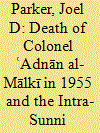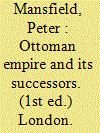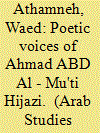| Srl | Item |
| 1 |
ID:
177661


|
|
|
|
|
| Summary/Abstract |
This article reconsiders the simple minority-majority dichotomy that surrounded the death of Colonel ʿAdnān al-Mālkī who was a Sunni killed by an ʿAlawi in 1955. Nevertheless, it was not the ʿAlawi minority, or other non-Sunni minorities that drove the subsequent power struggle that arose in Syria. Rather what occurred was a battle for control of the identity, direction, and economic organization of the young state contested by two alternative networks of Sunni elites, namely ʿulemaʾ (religious-scholarly) families, and ʿaskerī (military-administrative) families, both of whose social origins can be found in Ottoman history. This study argues that al-Mālkī’s assassination temporarily weakened the Syrian ʿulemaʾ families’ position in the civil-military balance that undergirded Syrian society and allowed the ʿaskerī class to gain the initiative. Such a change is evidenced by Damascus’s turn toward the Soviet Union for arms as well as other state-building materials. The inability of these two competing internal networks to resolve their differences throughout the Cold War resulted in political dysfunction throughout the Cold War era. The ascent of Gamal ʿAbd al-Nasser to power with the creation of the United Arab Republic in 1958 proved a temporary abeyance in this struggle, but a final resolution came only much later when Hafez al-Assad became leader in 1970.
|
|
|
|
|
|
|
|
|
|
|
|
|
|
|
|
| 2 |
ID:
029561


|
|
|
|
|
| Edition |
1st ed.
|
| Publication |
London, Macmillan Press Ltd., 1973.
|
| Description |
vii, 210p.hbk
|
| Series |
Making of the 20th Century
|
|
|
|
|
|
|
|
|
|
|
|
Copies: C:1/I:0,R:0,Q:0
Circulation
| Accession# | Call# | Current Location | Status | Policy | Location |
| 013106 | 956/MAN 013106 | Main | On Shelf | General | |
|
|
|
|
| 3 |
ID:
124615


|
|
|
|
|
| Publication |
2013.
|
| Summary/Abstract |
This article examines the poetic voices of Egyptian poet Ahmad Abd al-Mu'ti Hijazi in five representative poems written between 1950 and 2011. It investigates the role of major political events in the Arab world on his trajectory and poetic voice. The article argues that Hijazi changes his poetic voice in relation to the status quo in Egypt. The article concludes that these voices conflict and clash with one another. Hijazi publishes a collection of poetry after the eruption of the Egyptian Revolution in January 2011, to inspire his people, protest against Mubarak's regime, and regain his poetic voice.
|
|
|
|
|
|
|
|
|
|
|
|
|
|
|
|
| 4 |
ID:
190113


|
|
|
|
|
| Summary/Abstract |
This article studies the Muslim Brotherhood’s (MB) second prison ordeal in Egypt between 1954–1964. Based on a collection of prison memoirs written by Brothers, the article explores in three parts how the MB developed socially, intellectually, and organisationally in prison during the reign of President Gamal Abdel Nasser. Beginning with the MB’s imprisonment in the aftermath of the President’s attempted assassination in 1954, the first part describes how the Brothers built a vibrant prison community for themselves within al-Wahat Camp. Against the backdrop of the Suez War in 1956, the second part demonstrates the debates that erupted among the Brothers on whether to support Nasser in the event of a war with Israel and the West. Following the Brothers’ ideological and physical separation between so-called Supporters and Opponents, the third part explores how an increasing antipathy towards Nasser developed among some of the Brothers in al-Mahariq Prison until their unexpected release in 1964. Thus, by acknowledging the prison institution as a crucial site for ideology-formation, this article ultimately seeks to explore not what state repression restricted the Brothers from doing, but what they managed to do in spite of it.
|
|
|
|
|
|
|
|
|
|
|
|
|
|
|
|